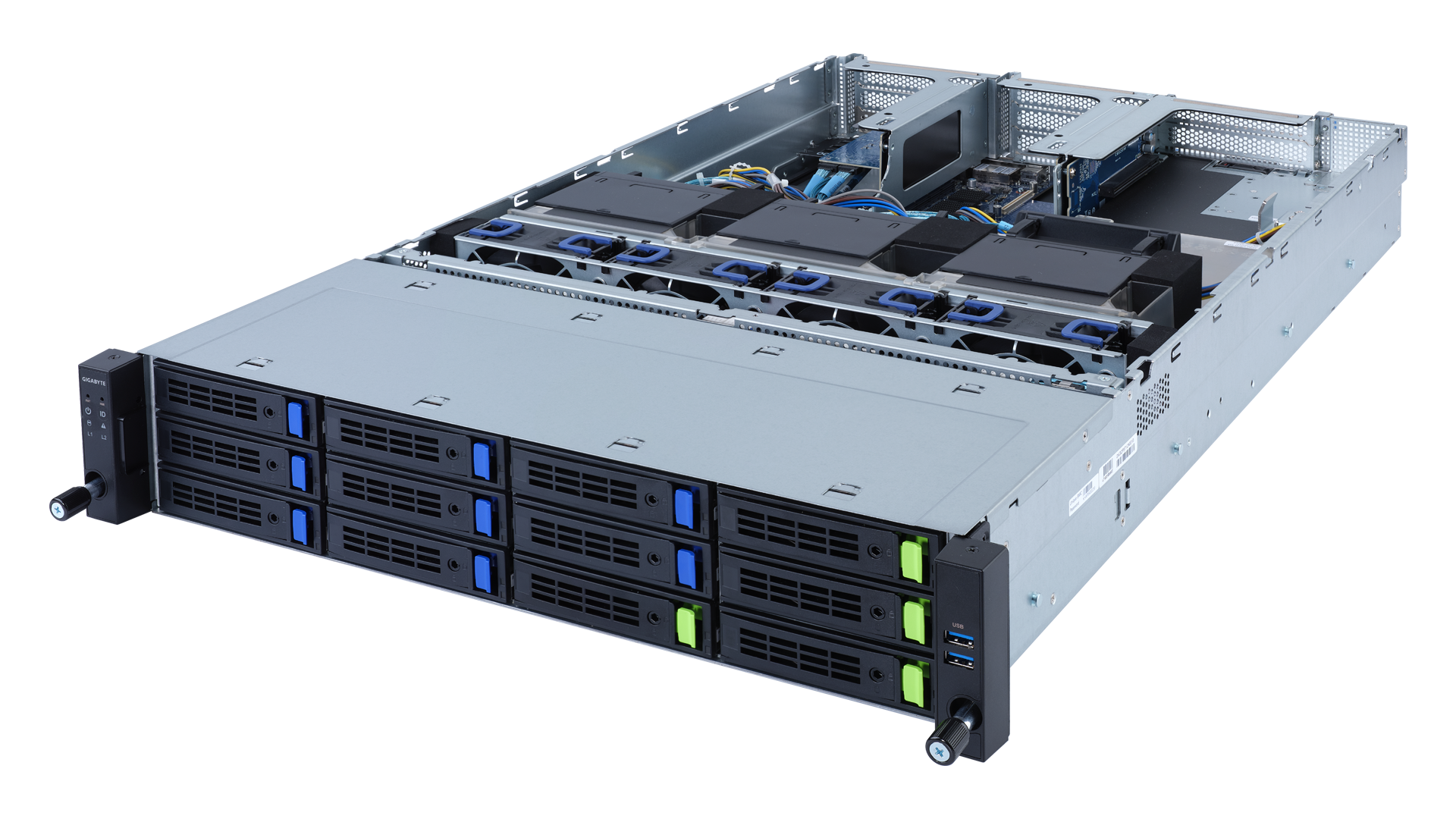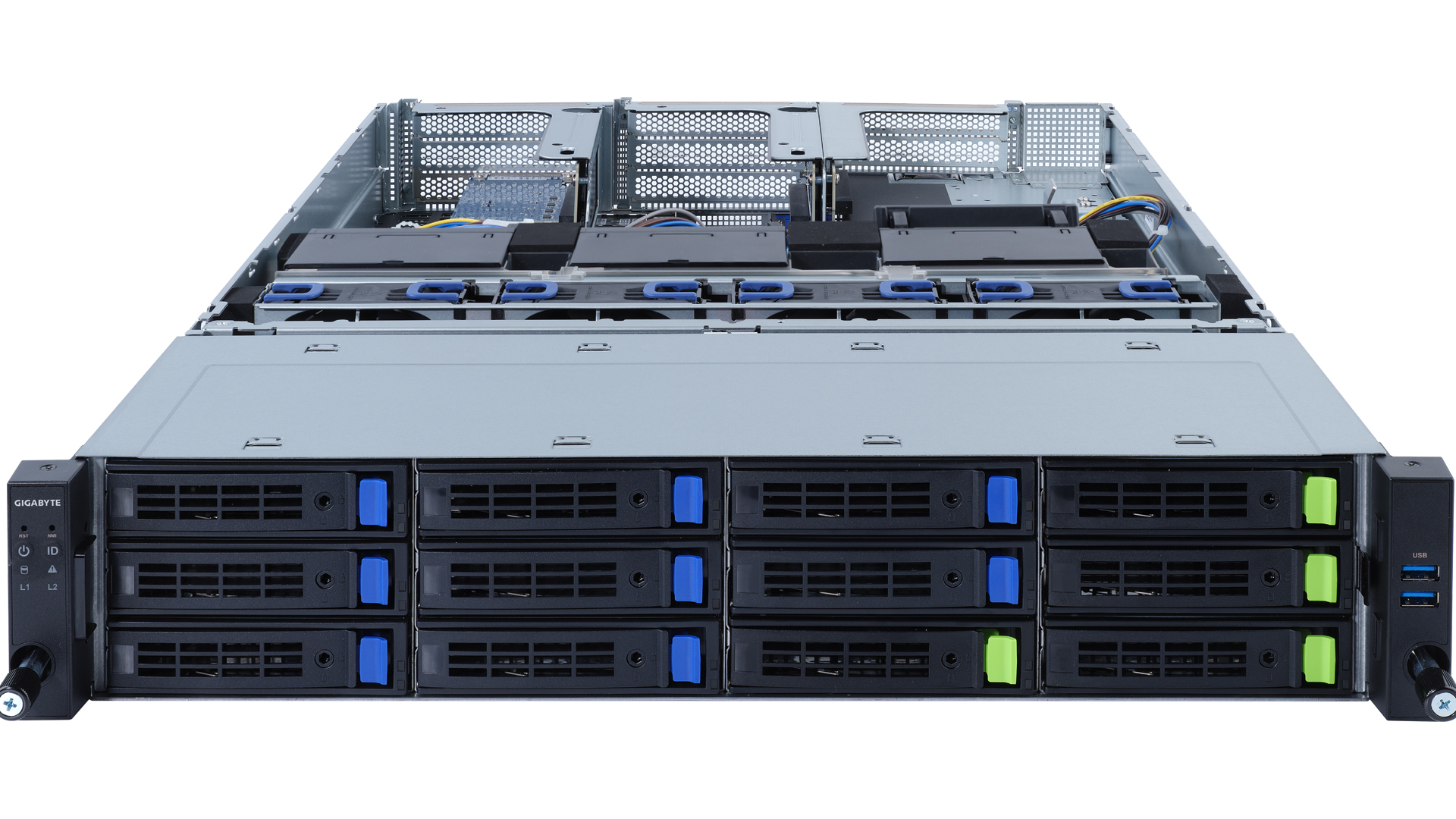Flexible server options with the Gigabyte R282-Z96
With support for AMD’s latest 3rd Generation EPYC processors, the R282-Z96 is a server that’s designed to be the optimal platform for a very wide range of different workloads

AMD’s EPYC processors have taken the capabilities of servers to a new level. The unprecedented core count, performance and features give servers based on this technology a huge range of applications and enormous flexibility. For example, the Gigabyte R282-Z96 is a dual-socket 2U rack mount server available in a wide variety of configurations to suit different workloads and use case scenarios.
Central to the R282-Z96 is the support for the latest generation of AMD EPYC 7003 series processors, codenamed “Milan”. The 7003 series builds on the already extensive capabilities of AMD EPYC 7001 “Naples” and 7002 “Rome”. Each 7003 series CPU can integrate up to 64 cores, meaning the dual-socket R282-Z96 server supports up to 128 cores and 256 threads in total, designed to enable compute-intensive workloads including HPC. The new 7003 series CPUs now include a 32MB Level 3 cache, accessible to all cores equally, with the goal of reducing memory latency and improving performance for big datasets and large virtual machines.
Servers such as the R282-Z96 with support for high core-counts are particularly useful in highly virtualised environments. The high core density means that acquisition costs to support a given number of virtual machines is less than buying multiple servers with lower numbers of cores, and this is also accompanied by an overall lower power consumption in a large-scale rollout with associated lower total cost of ownership.
A further essential component of a strong virtualisation platform is the speed and total capacity of memory it can be supplied with. Since the 7002 series, AMD EPYC processors have supported up to 4TB of quick 3200MHz DDR4 memory in an eight-channel configuration. The R282-Z96 can accommodate up to 32 RDIMMs or LRDIMMs with 128GB on each module, meaning it can support up to the full 4TB capability of the AMD EPYC processor. In a virtualisation scenario requiring potent multi-core VMs with lots of memory each, the capacities on display here indicate the potential to support large numbers of well-specified VMs.
A key advantage of AMD EPYC processors over competitor CPUs is support for PCI Express 4 and 128 lanes per CPU. This provides a lot of options for fast peripherals and storage. The R282-Z96 is incredibly flexible in terms of support for different storage configurations. It can handle up to 12 hot-swappable 3.5in drives, four of which can be PCI Express 4 NVMe SSDs, providing the option for lots of extremely fast main storage. PCIe 4’s 64GB/sec maximum bandwidth will be a huge benefit for virtualisation but also for database analytics applications, where large capacities of fast memory and low-latency Level 3 cache configuration can combine with high-bandwidth storage to make crunching large datasets faster and more efficient.
For applications where capacity is more important than sheer speed, the support for eight more SATA or SAS drives (SAS requiring the appropriate peripheral card) means that the R282-Z96 can host many terabytes of storage. This also includes a selection of hot-swap bays available for redundant configurations. With high volumes of redundant drives, a single server can provide a significant RAID-protected storage array without the need for external storage and a separate storage-only network such as Fibre Channel.

The R282-Z96 also offers four PCI Express 16x slots, three of which can be populated with dual-width GPUs. This is enough capacity to support a very powerful GPU compute platform using either AMD Instinct or NVIDIA GPUs. The Gigabyte platform is also NVIDIA-certified for scalability, functionality, security, and performance. This provides multiple options for dense GPU compute on the Gigabyte platform, with a range of potential applications. One is virtualisation with hardware GPU acceleration, which is increasingly important for supplying VMs for end user workloads such as virtual desktops. This kind of workload is now being used for graphics-intensive tasks such as engineering, oil and gas visualisation, content creation and CAD/CAM, so it’s increasingly important to be able to offer strong GPU acceleration options with a rack server platform.
GPU compute is also of growing importance for emerging machine learning and AI applications, which require this alongside powerful CPU compute to deliver insights. It’s also a necessity for industrial applications such as computer vision, where fast real-time processing of video images for facial recognition and predictive activity analytics require GPU acceleration. Another application that can benefit from the R282-Z96’s support for multiple powerful graphics accelerators is digital signage. Strong GPU compute platforms can form the core of a system driving an array of public screens showing advertising and promotional messages, potentially up to very high pixel resolutions.
When looking at a hyper-converged infrastructure (HCI) system, servers that can combine excellent core density, large memory, and potential for lots of fast storage make an appealing proposition. Having these three features in one box negates the need for a separate storage array and associated infrastructure alongside the compute nodes. HCI can be delivered to a large number of users from a single box, or consolidated rack with everything in one place for maximum management efficiency and reduced TCO.
In addition to high core counts, the AMD EPYC platform also promises robust security. The processor has unique hardware-based security features via its Infinity Guard technology. This includes Secure Root-of-Trust, which prevents attacks at the firmware level, secure memory encryption that prevents cold boot attacks, and secure encrypted virtualisation, which prevents VMs from accessing each other. This keeps VMs separate so even if one is compromised, it cannot be used as a beachhead for compromising any others. The 3rd Generation EPYC processors have added Secure Nested Paging, which further strengthens VM isolation. Best of all, as these features operate at the hardware level, there is no extra software support required for IT departments that want to run the Gigabyte R282-Z96 for virtualisation workloads without worrying about security.
A fully stocked server with dual processors, multiple GPUs and lots of storage also needs a strong dependable power supply. To power its components, the Gigabyte R282-Z96 features dual-redundant 2,000W PSUs with 80 PLUS Platinum efficiency, designed to supply power without interruption, even in the event of a PSU failure.
The Gigabyte R282-Z96 server platform aims to showcase the abilities of the latest 3rd Generation AMD EPYC processors. It supports AMD’s maximum core density, the option of up to 4TB of fast eight-channel memory, multi-GPU acceleration and massive storage capacity, all in one 2U rack mount system. With its sights set on a diverse range of server workloads from big data analytics and HPC to virtualisation and HCI, the Gigabyte R282-Z96 is a platform that’s built to be flexible.
Find out how Gigabyte servers can take your organisation’s compute needs to the next level.
Get the ITPro daily newsletter
Sign up today and you will receive a free copy of our Future Focus 2025 report - the leading guidance on AI, cybersecurity and other IT challenges as per 700+ senior executives
ITPro is a global business technology website providing the latest news, analysis, and business insight for IT decision-makers. Whether it's cyber security, cloud computing, IT infrastructure, or business strategy, we aim to equip leaders with the data they need to make informed IT investments.
For regular updates delivered to your inbox and social feeds, be sure to sign up to our daily newsletter and follow on us LinkedIn and Twitter.


